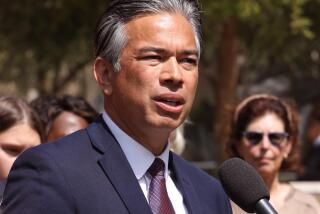Overlay Is Overruled in Favor of 2 Area Codes
- Share via
Bowing to public opposition to overlay an existing telephone area code with a second one, a state administrative law judge has recommended a plan to divide the 818 area code geographically, but delay its implementation to consider number-conservation measures.
The draft decision, issued late Monday by Judge Thomas R. Pulsifer, reverses his earlier tentative one calling for an overlay in the San Fernando Valley.
Reached Tuesday at his San Francisco office, Pulsifer said he changed his mind after learning of the adamant opposition to the overlay from residents and business owners in the 310 region, who cited the inconvenience of dialing 11 digits to make local calls.
“There had been a significant number of customers in the 310 area code expressing their disagreement with [11-digit] dialing there, and 818 is adjacent to 310,” Pulsifer said.
Pulsifer’s decision is not final, and the Public Utilities Commission may vote for a split, overlay or an alternative proposal. The five-member panel is expected to vote on the matter Sept. 16.
Under an overlay, a new area code is superimposed over the existing code and is required for new phone connections--even those within the same building.
A split would divide the Valley into two area codes, officials said. Four Valley-area exchanges, each containing several prefixes--Agoura, Canoga Park, Reseda and Van Nuys--would get a new area code that has yet to be determined, while the remaining 12 Valley exchanges would retain the 818 code.
In weighing public comments regarding area code splits and overlays, Pulsifer said there was a strong desire among customers to divide the Valley to keep seven-digit dialing, rather than suffer the inconvenience of dialing 11 digits for local calls required by an overlay.
Assemblyman Wally Knox, (D-Los Angeles), who has introduced legislation to adopt number-conservation measures and block future overlays and splits, said Pulsifer’s decision shows that state regulators refuse to consider alternatives to splits and overlays.
“This tentative decision still buys into the false choice of splits and overlays,” Knox said, adding that the proposed split “pits the northeast Valley against the southwest Valley.”
Opposition to the overlay has mounted since June 30 when Pulsifer recommended the plan to the PUC over an alternative plan to divide the 818 area.
The overlay is actively opposed by the Los Angeles County Board of Supervisors, Los Angeles City Council, City Atty. James Hahn, the Utility Reform Network and the Utility Consumer Action Network, as well as state Sen. Richard Alarcon (D-Sylmar).
Nevertheless, telecommunications companies, including Pacific Bell, GTE, MCI, AT & T, MediaOne Telecommunications, and other trade associations say a split or an overlay is needed to accommodate a surge in demand for additional telephone lines.
Pac Bell and GTE, the two largest companies in Los Angeles, are pressing for an area code overlay because it would add another 7.9 million numbers to the calling area, company officials said. The 818 area code can be overlaid three or four times, ensuring that the original calling area would remain in place indefinitely.
Business groups, including the California Small Business Assn., the Valley Industry and Commerce Assn., and United Chambers of Commerce of the San Fernando Valley prefer an overlay because businesses would avoid the expense of changing stationery, advertisements and Web sites as well as notifying clients of the new area code.
Ellen Fitzmaurice, VICA’s telecommunications committee co-chair, said the organization is adamantly opposed to a split.
“This is a massive business problem for entities that are forced to have to change their numbers,” Fitzmaurice said. “There is also the cost of lost customers.”
Fitzmaurice said her organization, which represents hundreds of Valley businesses, declared its support last October for an overlay.
“Clearly an overlay is less disruptive,” she said. “There is too much being made of this four-digit thing. All of this brouhaha has done exactly what we thought it would do: force a split.”
Ross Hopkins, president of the United Chambers of Commerce of the San Fernando Valley, said the organization remains opposed to the split because an overlay is too costly to businesses.
“I hate to say this but it’s only going to be a few years before everyone is going to have to dial 11 digits,” he said. “That’s just a fact of life.”
More to Read
Sign up for Essential California
The most important California stories and recommendations in your inbox every morning.
You may occasionally receive promotional content from the Los Angeles Times.













